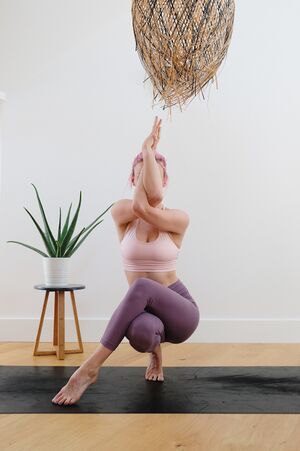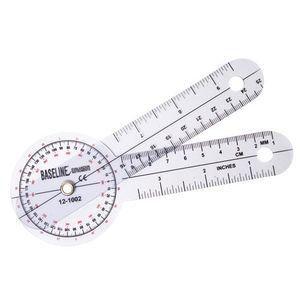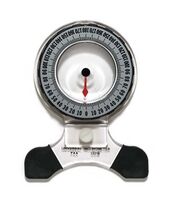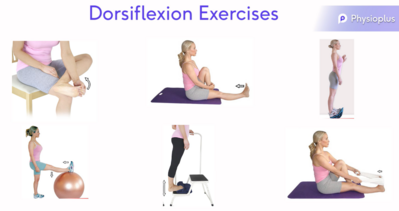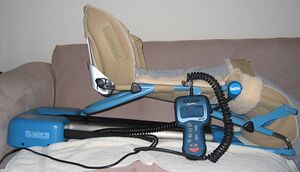Range of Motion: Difference between revisions
No edit summary |
No edit summary |
||
| Line 13: | Line 13: | ||
Range of motion therapy is beneficial in healing and in recovery from soft tissue and joint lesions, maintaining existing joint and soft tissue mobility, minimizing the effects of contracture formation, assisting neuromuscular reeducation, and enhancing synovial movement<ref name=":0">Hudson S. [https://www.sciencedirect.com/science/article/pii/B9780323046794100280 Rehabilitation Methods and Modalities for the Cat]. InHandbook of Veterinary Pain Management 2009 Jan 1 (pp. 538-577). Mosby. Available:https://www.sciencedirect.com/science/article/pii/B9780323046794100280 (accessed 25.10.2021)</ref>. | Range of motion therapy is beneficial in healing and in recovery from soft tissue and joint lesions, maintaining existing joint and soft tissue mobility, minimizing the effects of contracture formation, assisting neuromuscular reeducation, and enhancing synovial movement<ref name=":0">Hudson S. [https://www.sciencedirect.com/science/article/pii/B9780323046794100280 Rehabilitation Methods and Modalities for the Cat]. InHandbook of Veterinary Pain Management 2009 Jan 1 (pp. 538-577). Mosby. Available:https://www.sciencedirect.com/science/article/pii/B9780323046794100280 (accessed 25.10.2021)</ref>. | ||
== Measuring | == Measuring Range of Motion == | ||
[[File:Goniometer1.jpg|300x300px|Goniometer|alt=|right|frameless]] | [[File:Goniometer1.jpg|300x300px|Goniometer|alt=|right|frameless]] | ||
Devices to measure range of motion in the joints of the body include the [[Goniometer]] (image 2) and Inclinometer (image 3). Both use a stationary arm, protractor, fulcrum, and movement arm to measure angle from axis of the joint).<ref>Gajdosik RL, Bohannon RW. [https://academic.oup.com/ptj/article-abstract/67/12/1867/2728156 Clinical measurement of range of motion: review of goniometry emphasizing reliability and validity.] Physical therapy 1987;67(12):1867-72.</ref> | Devices to measure range of motion in the joints of the body include the [[Goniometer]] (image 2) and Inclinometer (image 3). Both use a stationary arm, protractor, fulcrum, and movement arm to measure angle from axis of the joint).<ref>Gajdosik RL, Bohannon RW. [https://academic.oup.com/ptj/article-abstract/67/12/1867/2728156 Clinical measurement of range of motion: review of goniometry emphasizing reliability and validity.] Physical therapy 1987;67(12):1867-72.</ref> | ||
| Line 21: | Line 21: | ||
* The short arm goniometer is used for smaller joints like the wrist, elbow, or ankle, | * The short arm goniometer is used for smaller joints like the wrist, elbow, or ankle, | ||
* The long arm goniometers are more accurate for joints with long levers like the knee and hip joints<ref>Gandbhir VN, Cunha B. [https://www.ncbi.nlm.nih.gov/books/NBK558985/ Goniometer]. Available: https://www.ncbi.nlm.nih.gov/books/NBK558985/<nowiki/>(accessed 25.10.2021)</ref> | * The long arm goniometers are more accurate for joints with long levers like the knee and hip joints<ref>Gandbhir VN, Cunha B. [https://www.ncbi.nlm.nih.gov/books/NBK558985/ Goniometer]. Available: https://www.ncbi.nlm.nih.gov/books/NBK558985/<nowiki/>(accessed 25.10.2021)</ref> | ||
<br> | |||
Tape measures can also be used to measure range of motion in some specific parts of the body (lumbar range of motion). | Tape measures can also be used to measure range of motion in some specific parts of the body (lumbar range of motion). | ||
| Line 28: | Line 28: | ||
There are three types of range of motion exercises | There are three types of range of motion exercises | ||
# Passive range of motion: Movement applied to a joint solely by another person or persons or a passive motion machine. When passive range of motion is applied, the joint of an individual receiving exercise is completely relaxed while the outside force moves the body part, such as a leg or arm, throughout the available range. | # Passive range of motion: Movement applied to a joint solely by another person or persons or a passive motion machine. When passive range of motion is applied, the joint of an individual receiving exercise is completely relaxed while the outside force moves the body part, such as a leg or arm, throughout the available range. | ||
# Active range of motion: Movement of a joint provided entirely by the individual performing the exercise. In this case, there is no outside force aiding in the movement. | # Active range of motion: Movement of a joint provided entirely by the individual performing the exercise. In this case, there is no outside force aiding in the movement. | ||
| Line 154: | Line 153: | ||
|30 | |30 | ||
|} | |} | ||
== Causes of Limited Range of Motion == | == Causes of Limited Range of Motion == | ||
Limited range of motion refers to a joint that has a reduction in its ability to move. Motion may be limited because of a problem within the joint, swelling of tissue around the joint, stiffness of the muscles, or pain.<ref>Magee DJ. Primary care assessment. In: Magee DJ, ed. ''Orthopedic Physical Assessment''. 6th ed. St Louis, MO: Elsevier Saunders; 2014:chap 17 [https://medlineplus.gov/ency/article/003173.htm <nowiki>''</nowiki>Limited range of motion]</ref> | Limited range of motion refers to a joint that has a reduction in its ability to move. Motion may be limited because of a problem within the joint, swelling of tissue around the joint, stiffness of the muscles, or pain.<ref>Magee DJ. Primary care assessment. In: Magee DJ, ed. ''Orthopedic Physical Assessment''. 6th ed. St Louis, MO: Elsevier Saunders; 2014:chap 17 [https://medlineplus.gov/ency/article/003173.htm <nowiki>''</nowiki>Limited range of motion]</ref> | ||
Medical conditions associated with a limited range of motion in the joints include: | Medical conditions associated with a limited range of motion in the joints include: | ||
* [[Ankylosing Spondylitis (Axial Spondyloarthritis)|Ankylosing Spondylitis]] | * [[Ankylosing Spondylitis (Axial Spondyloarthritis)|Ankylosing Spondylitis]] | ||
* [[Osteoarthritis]] (OA) | * [[Osteoarthritis]] (OA) | ||
| Line 168: | Line 167: | ||
* [[Congenital torticollis|Congenital Torticollis]] | * [[Congenital torticollis|Congenital Torticollis]] | ||
* [[Syphilis]], which is a sexually transmitted infection (STI) | * [[Syphilis]], which is a sexually transmitted infection (STI) | ||
<br> | |||
Other causes of restricted range of motion include: | Other causes of restricted range of motion include: | ||
* [[Inflammation Acute and Chronic|Inflammation]] of the soft tissues surrounding the joint, or joint swelling | * [[Inflammation Acute and Chronic|Inflammation]] of the soft tissues surrounding the joint, or joint swelling | ||
* Muscle Stiffness | * Muscle Stiffness | ||
| Line 179: | Line 177: | ||
== Physiotherapy == | == Physiotherapy == | ||
[[File:Dorsiflexion Stretch Exercises.png|right|frameless|399x399px]]There are many reasons for seeing a physiotherapists if movement is reduced at a join. Range of motion therapy benefits | [[File:Dorsiflexion Stretch Exercises.png|right|frameless|399x399px]]There are many reasons for seeing a physiotherapists if movement is reduced at a join. Range of motion therapy benefits | ||
* Healing and in recovery from [[Soft Tissue Injuries|soft tissue]] and joint lesions | * Healing and in recovery from [[Soft Tissue Injuries|soft tissue]] and joint lesions | ||
* Maintaining existing [[Joint Classification|joint]] and soft tissue mobility | * Maintaining existing [[Joint Classification|joint]] and soft tissue mobility | ||
| Line 185: | Line 182: | ||
* Assisting [[Neuromuscular Exercise Program|neuromuscular]] reeducation | * Assisting [[Neuromuscular Exercise Program|neuromuscular]] reeducation | ||
* Enhancing [[Synovium & Synovial Fluid|synovial]] movement<ref name=":0" />. | * Enhancing [[Synovium & Synovial Fluid|synovial]] movement<ref name=":0" />. | ||
<br> | |||
Range of movement exercises can: | Range of movement exercises can: | ||
* Increase movement at a joint | * Increase movement at a joint | ||
* Increase the function of a joint and the whole limb | * Increase the function of a joint and the whole limb | ||
| Line 195: | Line 191: | ||
* Improve and maintain joint integrity | * Improve and maintain joint integrity | ||
[[File:1024px-Continuous Passive Motion Machine.jpeg|right|frameless]] | [[File:1024px-Continuous Passive Motion Machine.jpeg|right|frameless]] | ||
Regaining range of motion in a joint is one of the first phases of injury rehabilitation and a physiotherapy assessment will be performed prior to prescribing a range of movement exercises. The assessment looks at the range and the quality of the movement. | <br>Regaining range of motion in a joint is one of the first phases of injury rehabilitation and a physiotherapy assessment will be performed prior to prescribing a range of movement exercises. The assessment looks at the range and the quality of the movement. | ||
* Joints maintain a balanced range of motion by regular use and stretching of the surrounding soft tissues. Just 10 minutes of stretching three times a week can help improve range of motion. | * Joints maintain a balanced range of motion by regular use and stretching of the surrounding soft tissues. Just 10 minutes of stretching three times a week can help improve range of motion. | ||
* Quite often [[Strength Training|strengthening exercises]] are prescribed alongside or shortly after range of movement exercises as the increased movement at a joint without increasing the strength could cause a further injury<ref>Physio uk [https://www.physio.co.uk/treatments/physiotherapy/range-of-movement-exercises.php ROM exercises] Available: https://www.physio.co.uk/treatments/physiotherapy/range-of-movement-exercises.php<nowiki/>(accessed 25.10.2021)</ref>. | * Quite often [[Strength Training|strengthening exercises]] are prescribed alongside or shortly after range of movement exercises as the increased movement at a joint without increasing the strength could cause a further injury<ref>Physio uk [https://www.physio.co.uk/treatments/physiotherapy/range-of-movement-exercises.php ROM exercises] Available: https://www.physio.co.uk/treatments/physiotherapy/range-of-movement-exercises.php<nowiki/>(accessed 25.10.2021)</ref>. | ||
| Line 205: | Line 200: | ||
*[https://www.verywellhealth.com/overview-range-of-motion-2696650 Verywell health] | *[https://www.verywellhealth.com/overview-range-of-motion-2696650 Verywell health] | ||
*[https://www.movementforlife.com/blog/range-of-motion-exercises.php Movement for life blog][https://uk.humankinetics.com/blogs/excerpts/measuring-range-of-motion Human kinetics blog] | *[https://www.movementforlife.com/blog/range-of-motion-exercises.php Movement for life blog][https://uk.humankinetics.com/blogs/excerpts/measuring-range-of-motion Human kinetics blog] | ||
== References == | == References == | ||
<references /> | |||
[[Category:Rehabilitation Foundations]] | [[Category:Rehabilitation Foundations]] | ||
[[Category:Goniometry]] | [[Category:Goniometry]] | ||
Revision as of 23:04, 26 February 2022
Original Editor - SULEIMAN USMAN Top Contributors - Angeliki Chorti, Lucinda hampton, SULEIMAN USMAN, Kapil Narale, Naomi O'Reilly, Shaimaa Eldib, Vidya Acharya, Shreya Pavaskar, Mariam Hashem, Kim Jackson and Leana Louw
Introduction[edit | edit source]
Range of motion is the capability of a joint to go through its complete spectrum of movements. Range of motion of a joint can be passive or active.
- Passive range of motion can be defined as the range of motion that is achieved when an outside force (such as a therapist) causes movement of a joint and is usually the maximum range of motion that a joint can move.
- Active range of motion is the range of motion that can be achieved when opposing muscles contract and relax, resulting in joint movement. For example, the active range of motion to allow the elbow to bend requires the biceps to contract while the triceps muscle relaxes. Active range of motion is usually less than passive range of motion.
Range of motion therapy is beneficial in healing and in recovery from soft tissue and joint lesions, maintaining existing joint and soft tissue mobility, minimizing the effects of contracture formation, assisting neuromuscular reeducation, and enhancing synovial movement[1].
Measuring Range of Motion[edit | edit source]
Devices to measure range of motion in the joints of the body include the Goniometer (image 2) and Inclinometer (image 3). Both use a stationary arm, protractor, fulcrum, and movement arm to measure angle from axis of the joint).[2]
Of all the types, a universal goniometer is most widely used
Universal Goniometer - comes in two forms: short arm and long arm.
- The short arm goniometer is used for smaller joints like the wrist, elbow, or ankle,
- The long arm goniometers are more accurate for joints with long levers like the knee and hip joints[3]
Tape measures can also be used to measure range of motion in some specific parts of the body (lumbar range of motion).
Range of Motion Exercises[edit | edit source]
Range of motion exercise refers to activity aimed at improving movement of a specific joint. This motion is influenced by several structures: configuration of bone surfaces within the joint, joint capsule, ligaments, tendons, and muscles acting on the joint.
There are three types of range of motion exercises
- Passive range of motion: Movement applied to a joint solely by another person or persons or a passive motion machine. When passive range of motion is applied, the joint of an individual receiving exercise is completely relaxed while the outside force moves the body part, such as a leg or arm, throughout the available range.
- Active range of motion: Movement of a joint provided entirely by the individual performing the exercise. In this case, there is no outside force aiding in the movement.
- Active assist range of motion: Joint receives partial assistance from an outside force. This range of motion may result from the majority of motion applied by an exerciser or by the person or persons assisting the individual. It also may be a half-and-half effort on the joint from each source.
Range of Motion Chart[edit | edit source]
Each joint has a normal ROM, while each person has a different amount of ability to achieve it. Below are generally accepted values for a normal ROM for some individual joints as measured in degrees
| Joint / Segment | Movement | Degrees |
|---|---|---|
| Wrist | Flexion | 60 |
| Extension | 60 | |
| Radial Deviation | 20 | |
| Ulnar Deviation | 20 | |
| Forearm | Pronation | 80 |
| Supination | 80 | |
| Elbow | Flexion | 140 |
| Extension | 0 | |
| Shoulder | Flexion | 180 |
| Hyperextension | 50 | |
| Abduction | 180 | |
| Adduction | 50 | |
| Shoulder with Abducted Arm | Internal Rotation | 90 |
| External Rotation | 90 | |
| Horizontal Adduction | - | |
| Horizontal Adduction | - | |
| Cervical Spine | Flexion | 60 |
| Hyperextension | 75 | |
| Lateral Flexion | 45 | |
| Rotation | 80 | |
| Lumbar-thoracic Spine | Flexion | 45-50 |
| Hyperextension | 25 | |
| Lateral Flexion | 25 | |
| Rotation | 30 | |
| Hip | Flexion | 100 |
| Hyperextension | 30 | |
| Abduction | 40 | |
| Adduction | 20 | |
| Internal Rotation | 40 | |
| External Rotation | 50 | |
| Knee | Flexion | 150 |
| Extension | 0 | |
| Ankle | Plantarflexion | 40 |
| Dorsiflexion | 30 |
Causes of Limited Range of Motion[edit | edit source]
Limited range of motion refers to a joint that has a reduction in its ability to move. Motion may be limited because of a problem within the joint, swelling of tissue around the joint, stiffness of the muscles, or pain.[5]
Medical conditions associated with a limited range of motion in the joints include:
- Ankylosing Spondylitis
- Osteoarthritis (OA)
- Rheumatoid Arthritis (RA)
- Juvenile RA, which is an autoimmune form of arthritis that occurs in children under the age of 16 years
- Cerebral Palsy (CP)
- Legg-Calve-Perthes disease.
- Sepsis of the hip and other joints, which is a bacterial infection of the joints
- Congenital Torticollis
- Syphilis, which is a sexually transmitted infection (STI)
Other causes of restricted range of motion include:
- Inflammation of the soft tissues surrounding the joint, or joint swelling
- Muscle Stiffness
- Pain
- Joint Dislocation
- Fractures [6]
Physiotherapy[edit | edit source]
There are many reasons for seeing a physiotherapists if movement is reduced at a join. Range of motion therapy benefits
- Healing and in recovery from soft tissue and joint lesions
- Maintaining existing joint and soft tissue mobility
- Minimizing the effects of contracture formation
- Assisting neuromuscular reeducation
- Enhancing synovial movement[1].
Range of movement exercises can:
- Increase movement at a joint
- Increase the function of a joint and the whole limb
- Improve movement efficiency
- Increase independence
- Decrease pain
- Improve and maintain joint integrity
Regaining range of motion in a joint is one of the first phases of injury rehabilitation and a physiotherapy assessment will be performed prior to prescribing a range of movement exercises. The assessment looks at the range and the quality of the movement.
- Joints maintain a balanced range of motion by regular use and stretching of the surrounding soft tissues. Just 10 minutes of stretching three times a week can help improve range of motion.
- Quite often strengthening exercises are prescribed alongside or shortly after range of movement exercises as the increased movement at a joint without increasing the strength could cause a further injury[7].
- Continuous Passive Movement Machine (CPM) is also used to maintain and improve ROM. Physiotherapists may use this machine post operative eg Total knee replacement[8].
- In paediatrics ROM exercises are used when all or some of the normal physical activities are not able to be completed due to the physical condition of the child. Attention is given to the joint not being used through provision of active or passive ROM exercises. Passive ROM exercises can be performed by the family member or the healthcare provider. Active ROM exercises are be performed by the child[9].
Resources[edit | edit source]
References[edit | edit source]
- ↑ 1.0 1.1 Hudson S. Rehabilitation Methods and Modalities for the Cat. InHandbook of Veterinary Pain Management 2009 Jan 1 (pp. 538-577). Mosby. Available:https://www.sciencedirect.com/science/article/pii/B9780323046794100280 (accessed 25.10.2021)
- ↑ Gajdosik RL, Bohannon RW. Clinical measurement of range of motion: review of goniometry emphasizing reliability and validity. Physical therapy 1987;67(12):1867-72.
- ↑ Gandbhir VN, Cunha B. Goniometer. Available: https://www.ncbi.nlm.nih.gov/books/NBK558985/(accessed 25.10.2021)
- ↑ Wem ROM by joint Available:https://www.wikem.org/wiki/Range_of_motion_by_joint (accessed 25.10.2021)
- ↑ Magee DJ. Primary care assessment. In: Magee DJ, ed. Orthopedic Physical Assessment. 6th ed. St Louis, MO: Elsevier Saunders; 2014:chap 17 ''Limited range of motion
- ↑ Healthline What Is Limited Range of Motion? Available:https://www.healthline.com/health/limited-range-of-motion (accessed 25.10.2021)
- ↑ Physio uk ROM exercises Available: https://www.physio.co.uk/treatments/physiotherapy/range-of-movement-exercises.php(accessed 25.10.2021)
- ↑ Samarpan Physiotherapy Clinic AHMEDABAD ROM Available: https://samarpanphysioclinic.com/ (accessed 25.10.2021)
- ↑ Nurse Key. ROM exercises Available: https://nursekey.com/range-of-motion-exercises/(accessed 25.10.2021)
